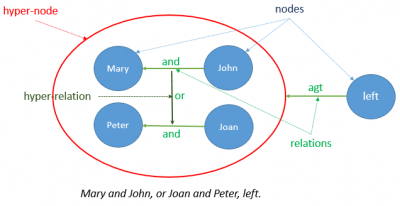Grammar units
From UNL Wiki
(Difference between revisions)
(Created page with "center ;Node :A node is the most elementary unit in the graph. It is the result of the tokenization process, and corresponds to the notion of "le...") |
|||
| (2 intermediate revisions by one user not shown) | |||
| Line 1: | Line 1: | ||
| − | [[file:grammar.png|center]] | + | [[file:grammar.png|center|400px]] |
;[[Node]] | ;[[Node]] | ||
| Line 6: | Line 6: | ||
:In order to form a natural language sentence or a UNL graph, nodes are inter-related by relations. In the UNL framework, there are three different types of relations: the linear (list) relation, syntactic relations and semantic relations. | :In order to form a natural language sentence or a UNL graph, nodes are inter-related by relations. In the UNL framework, there are three different types of relations: the linear (list) relation, syntactic relations and semantic relations. | ||
;[[Hyper-Node]] | ;[[Hyper-Node]] | ||
| − | :A hyper-node is a sub-graph, i.e., a node containing relations between nodes. | + | :A hyper-node is a sub-graph, i.e., a [[scope]]: a node containing relations between nodes. |
;[[Hyper-Relation]] | ;[[Hyper-Relation]] | ||
:A hyper-relation is a relation between relations. | :A hyper-relation is a relation between relations. | ||
Latest revision as of 01:15, 24 August 2013
- Node
- A node is the most elementary unit in the graph. It is the result of the tokenization process, and corresponds to the notion of "lexical item". At the surface level, a natural language sentence is considered a list of nodes, and a UNL graph a set of relations between nodes.
- Relation
- In order to form a natural language sentence or a UNL graph, nodes are inter-related by relations. In the UNL framework, there are three different types of relations: the linear (list) relation, syntactic relations and semantic relations.
- Hyper-Node
- A hyper-node is a sub-graph, i.e., a scope: a node containing relations between nodes.
- Hyper-Relation
- A hyper-relation is a relation between relations.
